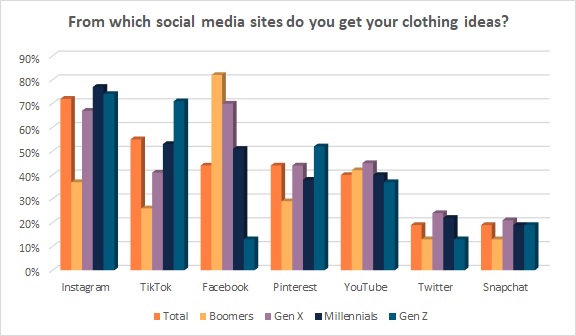There are 8 billion people in this world. And of them, 60 percent, or 4.88 billion, are active social media users. In the U.S., that number jumps to 74 percent. This poses a great opportunity for brands to connect with consumers. However, there are a bushel of social media platforms. And the users differ for each platform based on age as well as the content they want to see. That’s especially true for Gen Z and Millennials. For marketers, knowing the difference can make all the difference in connecting and capitalizing on social platforms.
“But even if a brand doesn’t think humor is part of their identity, there’s viral potential for everything — wholesome, lifestyle, DIY, you name it — and as long as it’s entertaining and personal, young consumers will be interested.
YPulse, “Gen Z and Millennials Are Looking for Different Content on Every Social Media Platform”
YPulse data shows Gen Z and Millennials are active on an average of six different social media platforms. And they’re going to each platform for different content.
“For brands, this means that content can’t be one size fits all,” states the YPulse Insights article. “They’ve got to pay attention to exactly what purpose each one serves for young audiences.”
Fully 81 percent of young consumers don’t want to see the same kind of content on every platform, according to the YPulse research. The firm also found 65 percent of young users don’t like when social media platforms create new features that replicate other social media sites – meaning, they want different content on each.
For example, in a YPulse survey of 13-to-39 year olds, users went to TikTok for memes and viral content (66 percent), content from online influencers (58 percent), random people they don’t know (57 percent), celebrities (49 percent), and their friends (46 percent). But when the same generations go to Instagram, they mostly seek content from their friends (66 percent), followed by celebrities (63 percent), online influencers (55 percent), brands/products (52 percent), and memes/viral content (51 percent).
The most popular social media platform for clothing ideas among Gen Z consumers is Instagram (74 percent), according to a 2023 Cotton Incorporated’s Lifestyle Monitor™Survey. That’s followed by TikTok (71 percent), Pinterest (52 percent), YouTube (36 percent), Snapchat (18 percent), Facebook (13 percent), X – formerly Twitter (13 percent), and Tumblr (2 percent).

Among consumers ages 25-to-34, the top platform is also Instagram (78 percent), according to the Monitor™ research. That’s also followed by TikTok (57 percent), Facebook (51 percent), YouTube (43 percent), Pinterest (38 percent), X – formerly Twitter (22 percent), Snapchat (19 percent), and Tumblr (5 percent).
Simon Kemp, founder of Kepios, a strategy consultancy, and DataReportal, an online reference library, says social media user numbers continue to grow. He says his firm’s latest research shows social media adoption accelerated +1.5 percent over the past three months. Total social media adoption increased 3.7 percent since July 2022.
“This figure marks another momentous milestone along our journey towards universal connectivity,” Kemp said in a recent video when the company presented its quarterly digital report.
In the last quarter, DataReportal’s research show females ages 16-to-24 spent the most time on social media, at 3 hours and 10 minutes per day. That was followed by females ages 25-to-34, spending two hours and 49 minutes per day on social platforms. Males ages 16-to-24 were next, at two hours and 35 minutes, followed by males ages 25-to-34 at two hours and 32 minutes. By comparison, men and women ages 55-to-64 average one hour and 40 minutes on social platforms per day.
That time spent on these platforms can translate into sales for apparel brands, especially among younger consumers. One-fifth (20 percent) of shoppers ages 13-to-24 say they have purchased a product directly from a social media post by clicking a link or image, according to 2020 Monitor™research. The number increases to 23 percent among Millennials.
Two-fifths (40 percent) of young consumers (ages 13-24) add that they’re likely to buy a product directly from a social media platform, according to the 2020 Monitor™ research.
Perhaps that’s why Pinterest is so popular with the younger set. YPulse research shows young consumers like that Pinterest offers in-post shopping where both creators and brands can tag the items they show, allowing users to purchase directly from the post. Gen Z and Millennials put Pinterest in the number one spot for the kind of content they want from brands, including product recommendations that are linked within aesthetically pleasing pictures.
YPulse research shows the other top platforms Gen Z and Millennials turn to for content from brands are Instagram, YouTube, and Facebook. Where Instagram is concerned, 52 percent of young consumers say they want to see brands and products in the app. They like that social shopping also doesn’t waste their time or divide their attention by bringing them to another site. Also, these shoppers want to see niche or personalized content on Instagram, versus viral posts.
When it comes to advertising, young consumers are most open to watching it on YouTube (63 percent), followed by Instagram and Facebook, according to YPulse’s Social and Mobile Marketing Preferences report. And they’re open to content from online influencers on every platform except Facebook and Snapchat – two platforms where they prioritize posts from family and friends. Whether it’s a major celebrity or micro influencer, more than half of all young people (54 percent) say they have purchased something after it was touted by an online celeb on social media.
Social media holds the top spot for young shoppers when it comes to a source of clothing ideas. Over two-fifths of all Gen Z shoppers (43 percent) and 37 percent of Millennials say they turn to social platforms for clothing inspo, according to 2023 Monitor™ research. That compares to 23 percent for Gen X and 7 percent for Boomers. Celebrities also hold more sway with younger consumers. Among Gen Z, 17 percent look to celebs as a source of clothing ideas, as do 17 percent of Millennials. That contrasts with 10 percent for Gen X and just 4 percent for Boomers.
Brands should keep in mind the U.S. Chamber of Commerce says the influencer marketing industry is expected to grow to $21.1 billion in 2023, citing data from The Influencer Marketing Benchmark Report.
Finally, YPulse says Gen Z and Millennial consumers love viral content, which explains why TikTok is so popular with this cohort.
“Lucky for brands, this kind of content is easy to get in on if done right – and is yet another way to blend ad and brand content into their feeds,” YPulse states in its Insights article. Since 49 percent of TikTok users want to see humor from brands, funny content is one way to connect with them. “But even if a brand doesn’t think humor is part of their identity, there’s viral potential for everything — wholesome, lifestyle, DIY, you name it — and as long as it’s entertaining and personal, young consumers will be interested.”
